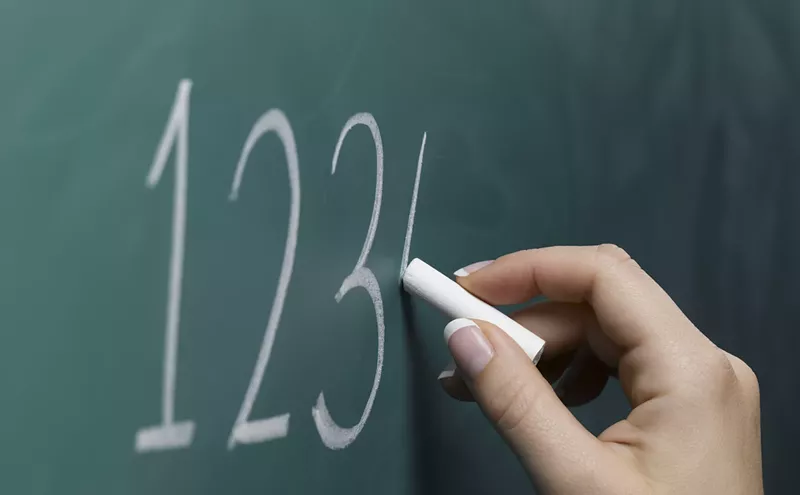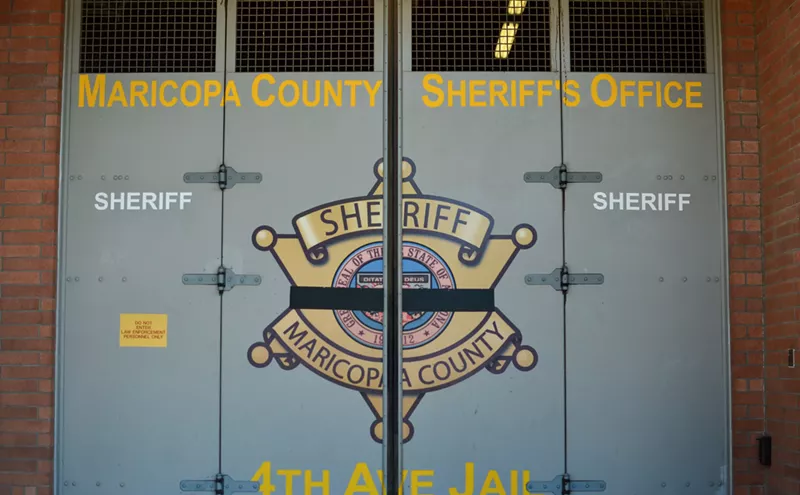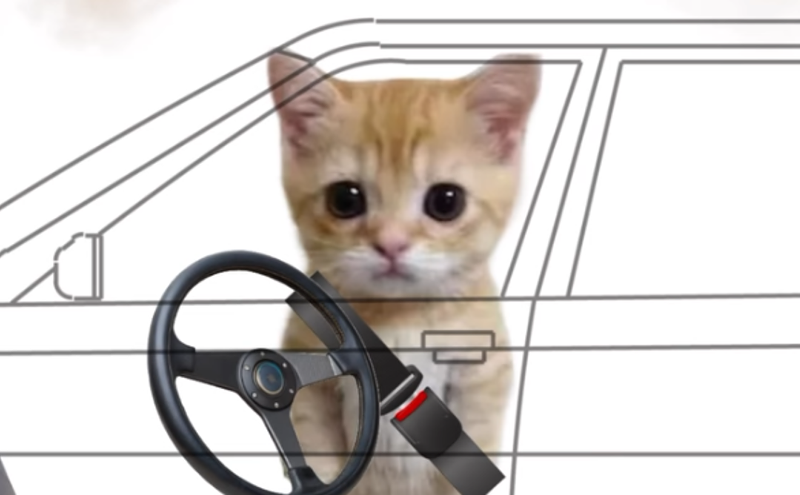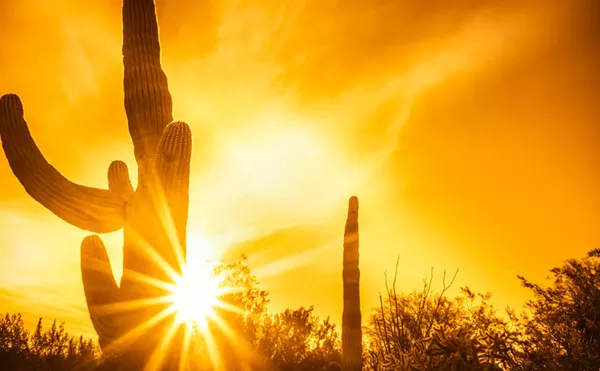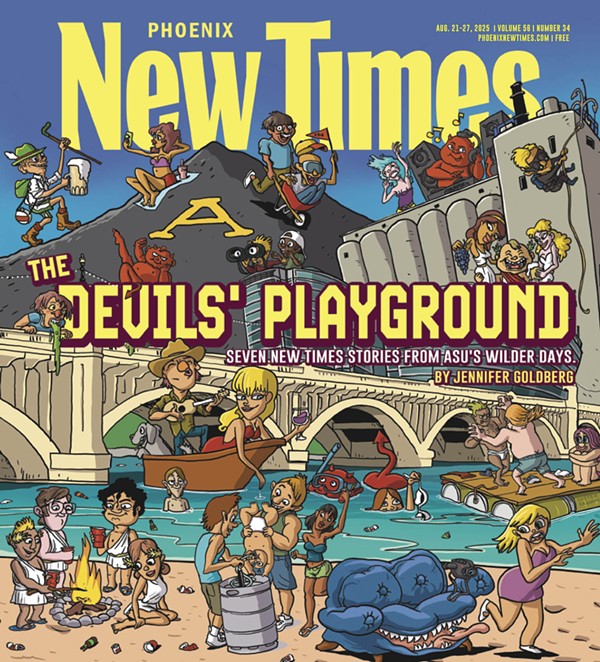Because he used wheel-alignment equipment made by the Bear Manufacturing Company, Moe had two huge bears painted on either side of the shop's bay door. The animals replicate in giant size the trademark of Bear Manufacturing. They are dark brown, and every bit as big as real bears, except that they are leaning over at the waist with what appears to be hilarity, and laughing happily.
When Moe Allen died of his bad habits, he was in the process of selling the business to Wally Marion, whom he had hired as his accountant in the late 1940s. Wally Marion hasn't changed the name of the shop, the kind of equipment used or very many of the employees.
Most significantly, he has not changed the laughing bears alongside the shop's doors. In fact, the bears are repainted every so often, when they begin to show the effects of the late-afternoon sun on the westward-facing wall and the fumes from the 16th Street bus.
For people in the neighborhood, the bears are a landmark. Wally Marion says, "When I tell people I own Moe Allen's, they say, 'Oh! The place with the bears!'"
Since the 1920s, wheel-alignment businesses using equipment made by Bear Manufacturing have displayed the company's trademark bear. Guys would open a shop, hang a double-sided metal bear over the sidewalk or plaster a couple on the front wall. Their customers knew the logo the way they'd know the Texaco star.
The actual bear of the trademark is not brown, like Moe Allen's, but yellow, like no bear in nature. Although he's usually holding a sign that says things like "Line Up With Bear," when he's shown without the sign, his arm is still extended in the sign-holding position, so he has about him the appearance of a slightly demented panhandler. Hey, brother, can you spare a tie rod?
The little yellow bear is possibly the cutest advertising trademark ever displayed in the United States. "It's American folk art at its best," says Jerry Keyser, publisher of Check the Oil magazine near Columbus, Ohio, which is devoted to automobile collectibles. It is impossible to look at this creature, bending over with laughter, and not feel somehow cheered about life in general, and optimistic in particular at what wonderful things could be introduced into your future if your car would only stop wandering all over the pavement.
On the bear's face is an expression of sheer joy, a laugh that is not at anybody's expense, or that contains the faintest hint of cruelty or unkindness. He is laughing a laugh that could only come from the complete innocence of a child, or the wisdom of a Buddhist monk.
By comparison, Smokey the Bear is a tight-assed bureaucrat completely devoid of humor. What can you say about a bear who lays a guilt trip on you about campfires? Smokey ran an ad campaign last year insisting that his correct name is Smokey Bear, and never appears in public without his trousers on.
The Happy Bear, his official name at Bear Manufacturing, never had any clothes to put on, which shows a primal innocence that contrasts nicely with Smokey's perverted modesty. Smokey is a middle-aged white guy, and has just about that much fun.
Bear signs began to disappear from the landscape in the 1960s and 1970s, partly because of more restrictive sign laws, and partly because of internal changes at Bear Manufacturing that would ultimately reduce it to a division of a larger company with the bland name of Automotive Diagnostics. The disappearance of a sign that had been so well-known prompted coverage a couple of years ago on Good Morning, America. The show ran a photo of the bear in one of those "what ever happened to" segments, which prompted a sharp reply from the folks at Automotive Diagnostics headquarters in Kalamazoo, Michigan, pointing out that the bear was still alive. Still, most of the bears that remain on display in this country are remnants, retained by sentimental owners loyal to Bear equipment, the kind of men who, like at Moe Allen, have stayed in the same place long enough to have mechanics die or retire rather than move on.
Phoenix, although it still lacks a decent football team, is singularly blessed in the bear department, a fact the town has yet to trumpet in its Chamber of Commerce promotions. For aficionados of the bear sign, this city is a gold mine. At least half a dozen wheel-alignment companies in Phoenix still use the bear to advertise their services. In addition to Moe Allen's bears, the three locations of Jack's Wheel Alignment use the cheerful little logo, as does Paul J.P. Johnson's over on 35th Avenue, Jim Wilson's on 16th Street, and J & L on McDowell. The bear transcends cultural and linguistic barriers--Tom Ocano's auto body shop on Buckeye uses the logo. His Spanish-speaking customers know it as the "osito."
While the little yellow bear advertising Bear Manufacturing's wheel-alignment products is not as instantly recognizable as, say, the Coca-Cola logo, it evokes a considerably greater emotional response.
Mention of the bear causes the woman who answers the phone at Hemmings Motor News ("Bible of the old car trade") to shriek in recognition and talk about the bear she used to walk by on her way to school 30 years ago on Long Island.
"It was like a major part of my childhood," she says.
This reaction is widespread; the number of people who love the bear appears to be exactly equal to the number of people who recognize it.
But unlike devotion to Coke memorabilia, affection for the Bear wheel-alignment bear is completely unorganized, which is somewhat odd in a country with a club devoted to every collectible artifact, childhood disorder and faded movie star. Through it all, the little bear has remained the same. He has never been updated, modernized or made politically correct, like Betty Crocker and Aunt Jemima. He has laughed the same laugh for 70 years, possibly because he has outlasted the founders of the company he represents and a number of management teams who have wanted to get rid of him.
"Anymore, people jump around with trademarks," says Hank Durham, owner of Lee's Front End on 32nd Street, which sports a fine-looking bear sign. "They change it around so it's different. But the bear has never changed."
Although Bear signs are not particularly collectible--mostly because they were made of cheap materials, and have stayed the same for 70 years--the little yellow bear has wormed its way into popular culture. That's thanks to the Grateful Dead, who loved the logo enough to steal it. Deny it though the band may, the Dead appropriated its bear from the wheel-alignment prototype, a theft Bear executives recognize, but don't feel the slightest bit litigious about.
Even Allan Sherman--remember him?--was a bear fan. The comic songwriter, popular in the early '60s, for some unaccountable reason took the bear and ran half a dozen tiny little pictures of it all along the edge of his album My Son the Celebrity. Since he's dead, it's too late to ask why.
It makes perfect sense that a warm and fuzzy teddy bear should be the spokesman for a fabric softener you use on baby diapers. It makes perfect sense that a similar bear advertise the baby formula Similac. It even makes sense that a sleepy-looking bear advertise the Travelodge motel chain, when you think about how bears gorge for a few months and then snooze away the entire winter.
But wheel alignment? What do smiley-faced bears have to do with wheel alignment?
"I'm going to assume the guy's last name was Bear," says George Patten, a mechanic at Moe Allen's for the past decade and a half. "I don't think the company was named after the logo. I think the name inspired the logo."
By sheer coincidence, the man who would know, the single greatest living authority on the history of the bear, lives in Ahwatukee. For more than two decades, Keith Andrews was in publicity and advertising at Bear Manufacturing. He went to work for the company in 1969, and spent years pushing Bear products. He'd promote Bear by passing out all-day suckers with Happy Bear faces on them, or he'd hire a guy to don a Happy Bear costume at an event. He still has piles of material from his days at Bear--old photos of promotions and awards celebrations--that testify to how well he did his job.
"We sold a hell of a lot of iron here," says Andrews, referring to the huge, heavy racks that mechanics traditionally did wheel alignments on. Some anonymous but effective sales manager, therefore, accounts for the satisfyingly large number of Bear signs in Phoenix.
Keith Andrews is a company man in the best sense of the word, loyal to the product and its name, but not blind to management errors that would compromise them. He's also one of those guys who will never retire. After moving with his wife into their new house in Ahwatukee, he took a full-time job as an airline ticket agent.
In Andrews' telling, how a bear got to be the trademark of a company that manufactures wheel-alignment equipment makes perfect sense. It also involves a little early automotive history.
Back in the old days, Andrews explains, you bought a car, you got a car. You didn't get lumbar support, air conditioning, cruise-o-matic or little rings of green light around the key. Hell, you didn't even get a fuel gauge. Luggage compartments? Oh, please.
Bear Manufacturing came into existence in Rock Island, Illinois, in 1917, making the luggage racks that held suitcases in place. Bear soon expanded into wheel alignments, since a trip of any length on early unpaved highways was almost certainly going to make one necessary.
The name Bear had nothing to do with anyone's family name, since the founders were Will and Henry Dammann. Andrews theorizes the company name came from a catch phrase of the day.
"There was a popular slang expression of the time, 'It's a bear,'" Andrews says. "It meant something was rugged or of top quality." Teddy bears--and even the management at Bear admits its trademark is a teddy bear--were in their first flush of popularity in those days. They'd been invented in 1902, following the famous hunting trip during which Teddy Roosevelt refused to shoot a bear cub, and were busy sweeping the world.
While the thinking behind the Dammanns' selection of the name Bear can never be known, the sophistication of their usual thought processes can be gauged. The slogan the brothers used in those early days was "Let Bear lug your luggage."
The Happy Bear, however, isn't as peculiar as the very first logo Bear used. Andrews shuffles through his stack of papers and produces a photocopy. It shows a realistic, growly sort of bear, one more likely to inspire thoughts of strength--one capable, even, of lugging your luggage. No matter his physical prowess, the bizarre dance the bear is doing prompts the thought the animal may be inebriated, which may be why he was fired and replaced by the Happy Bear. That happened sometime in the early 1920s, when the cutest corporate logo in the history of American business came into being.
For several decades, the Happy Bear was used to pitch Bear products to consumers. He appeared not just on signs over service stations and wheel-alignment shops, but in ads in mass-market magazines like the Saturday Evening Post. He was a consumer logo, much as the Gerber baby, the Breck girl or Uncle Ben.
For decades, people actually cared about what kinds of products were used to align the wheels of their cars, and they would go out of the way to take them to places that displayed the Bear sign.
Then the Bear Manufacturing Company fell prey to all the ills that corporations are heir to--takeovers, mergers, dumb CEOs.
"There have been a number of companies through the years that have wanted to recharacterize the bear, make him more modern," says Russ Bailey. He's vice president of North American sales at company headquarters in Kalamazoo, Michigan. Even over the phone, you can tell Russ is a down-to-earth guy you would like to know. "That was fought off. They were all jerks, anyway."
One of the jerks did succeed in getting rid of the bear-shaped business cards, while another actively campaigned to have the bear signs removed from shops. Bear even stopped manufacturing the cut-out metal signs, but the body-shop guys liked them so much, they kept them in place even when they'd gotten old and rusted, as almost all of them are now.
In the past few years, however, management seems to have wised up, possibly because it realized it was never going to get some shops to take their signs down, possibly because it realized it owned one of the classic trademarks in America.
Automotive Diagnostics is now committed to keeping the Bear name and trademark animal alive. And metal bear signs are once again available!
Chuck Artino, who has Camelback Garage on Seventh Street, displays one of these nouveau bears. He's still leaning over laughing, but he's holding a sign that says, "Bear Computerized Service." Artino is happy to show you his Bear equipment.
It consists of large black boxes, like deep freezes. These are engine analyzers, which are what Automotive Diagnostics sells now. So while the Happy Bear may never again enjoy the public recognition he had in the '40s and '50s, he does grace every single one of the large black analyzers that mechanics hook up to your engine. One of the engineers at Bear even figured out a way to get the little yellow bear to walk across the analyzer's computer screen. The bear marches along, grinning, hand extended, whenever the machine isn't busy discovering you need a $1,200 rebuild. You can tell that Campbell Fisher Ditko is a totally cool design firm as soon as you walk in the door and see the concrete floor, black ceiling, corrugated tin dividers and chairs in shapes inimical to comfort. You also realize that everything the three principals of the firm say will possess a certain Lettermanesque, postmodern irony. Nonetheless, they are perfectly nice men, and happy to share their thoughts on the bear logo. It turns out that they are not only familiar with it, but longtime fans. "I've loved it ever since I was a kid," says Mike Campbell. He, Greg Fisher and Steve Ditko are gathered around a table, scrutinizing the trademark.
"It's so bad, it's good," says Ditko. "No one would ever design this in a million years."
"Yeah," Fisher chimes in, pretending he's a serious design guy at a meeting, pulling an expensive piece of artwork from his briefcase. "`Here's an idea for a new business logo . . .'"
Ditko grabs the floor again, elaborating his point by talking about the eagle that advertises the Goldberg & Osborne law firm. "That's so bad, it's bad."
"The bear is great," says Fisher.
"It's timeless," says Campbell.
"Everyone knows the bear," says Ditko. What would a hip design firm produce if a wheel-alignment company asked Campbell Fisher Ditko to design a logo today?
"I would never, ever start with a bear," says Campbell. "Maybe some symbol of a wheel."
"Can you see us sitting in a meeting?" shouts Ditko, taking on the role of the guy making the presentation, and having the inspiration of a lifetime--Newton with the apple, Archimedes in the bathtub.
"`~A bear! With his hand out!'"
The room dissolves in laughter.
Guys who are handy enough to do wheel alignments tend to be handy with other things, as well, and so handpainted bears invariably spring up at shops with Bear equipment.
While Joe Powers has regulation metal signs obtained from Bear, his shop also sports a handpainted bear looking north on traffic tootling down 16th Street. Joe Powers' shop is called Jim Wilson Wheel Alignment. It appears to be a universal rule in the wheel-alignment business that no matter how long the original owner of the shop has been dead, his name must be retained.
Some previous owner--maybe Ken Fausey--painted the bear at Jim Wilson's. An unknown sign artist painted the doorway bears at Moe Allen's in 1955, although one or another of the mechanics does the repainting these days. Jack Thomas, whose three locations are designated "Official Bear Stations," took creativity the furthest. He actually made stencils of the Happy Bear, and used them to paint bears all over the shop.
"I still have the old stencils," he says. "You'd take a stencil and spray yellow and then spray a little red tongue."
The homemade bears at all these shops have been painted and repainted so many times over the years, they have diverged like Darwin's finches, isolated on the islands of the Galpagos, until bears at different shops have evolved into a number of different bear subspecies. The doorway bears at Moe Allen's look pretty much like the originals, but the bear that hangs over the sidewalk looks like a cousin making his living in the teddy bear line.
The bear at Jim Wilson's certainly has a grin, but he also has the morning-after look of a man paying for a hard night on the town. His jaw appears to be painfully dislocated--a condition even Joe Powers, looking at the sign as if for the first time, will grudgingly recognize. Although wheel-alignment guys tend to choke over the word "cute," they do show a remarkable devotion to a logo that is just that.
"That is the business, absolutely," says Joe Powers.
John Miner is sitting at his desk at the repair shop he manages in Glendale, his head in his hands. John does not appear to be having a good day. There may not be too many good days around this place. The shop fixes up used cars, some of them repos, before they're sold at West Valley Thrift Resale on Glendale Avenue.
When the topic of his bear signs is broached, however, John springs up. "They painted them over!" he says in dismay. John is young, slender and much too pleasant to suffer head-in-the-hands kinds of days. He leads the way outside and points up at the wall, and, sure enough, you can see all that remains of the two bears that used to grace the corner of the building.
Actually, the middle portion of the two bears had been missing for a number of years, but you can tell that the happy faces have been cruelly covered with white paint. The paint job appears to have been done pretty sloppily, since it entirely missed the two sets of feet. "It was about the only thing that smiled at me when I came to work in the morning," says John, actually looking distressed. He chats for a little bit, the afternoon being slow, and then offers his own contribution to historic Phoenix sign lore. "Did you see the names of the people who used to own this place?" John walks around to the other side of the building and proudly shows where, faded from the sun and left over from some previous incarnation of the structure, the prize-winning moniker "Gomer Moses" is painted on the wall. Clearly, John is cheering up. Gomer Moses is the sort of name a bear lover would cherish.
When he goes back inside, one of the mechanics is passing around a quesadilla that has arrived for lunch.




